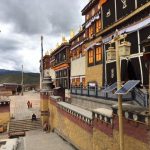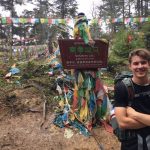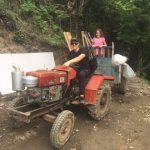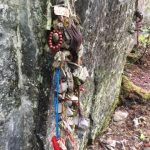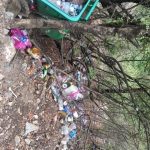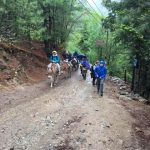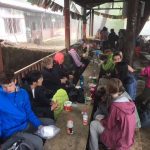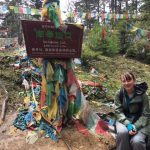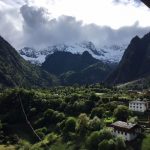Shangri-La
In the afternoon we had free time to explore Shangri-La but first we went as a group to the giant prayer wheel at the top of the hill above the city. The wheel is so big you need at least 8 people and as many as 30 people to push it. Coulson also showed off some off his cool acrobatic tricks.
Songzanlin Monastery
Just outside of Shangri-La lies the Songzanlin Tibetan Monastery. It is a beautiful complex built initially in 1697 at the direction of the fifth Dalai Lama. At its most prominent point in the 1980’s, it had a population of 270 monks. It still has a small active monk population that we got to see in a group meditation chant. There are thousands of Buddhist statues in all different forms and sizes representing different attributes of the Buddha. The walls, ceilings, and every surface are covered with paintings or cloth depicting Buddhist stories. It is truly remarkable. At the same time, the Chinese government has turned it into a tourist attraction with entrance fees so that takes some of the mysticism out of it.
Day 4: leaving Yubeng
Our hike out of Yubeng was 4.5 hours of downhill (7 miles) leaving the oasis of Yubeng and entering the desert cliffs of the Mekong river (which flows all the way to the ocean in Vietnam). The trail followed a narrow water pipe access trail built into the edge of the steep cliff ( not intimidating as long as you don’t look down). The change of the ecosystem was quite dramatic and several mentioned it looked like the Southwest and the Grand Canyon. Then we had a 4.5 hour drive to Shangri-La ( the old town in the picture below)
Day 3 Yubeng
On our third day of our Yubeng trek, Coulson, Cyrus, and I hiked up to the glacier fed lake below Meili Mountain (Kawakapo in Tibetan). The rest of the students stayed in Yubeng to rest and explore for the day. The hike took about 3 hours to get to the lake at 13,000 ft, our highest elevation yet. It was steep and tiring but offered a cool view of the glacier close up, a glacier that was covering the lake just 8 years before. The boys played on the snow and then we headed back for a dinner with some western options, such as spaghetti with tomato, onion and garlic.
Pilgrimage to the holy waterfall
On the 2nd day in Yubeng, we hiked to the holy waterfall where Tibetan pilgrims come to pray. The tradition is to circle the waterfall an odd number of times getting your clothes wet as the waterfall blesses and cleanses you. The hike was 7km one way, about 6 hours round trip up to 11,800 after passing through lower Yubeng at 10,000 ft. We saw a holy rock where local Tibetans believe a gateway to the heavens opened up many years ago and so they hang ropes and rock from it. Another rock had money stuck to it as an offering. Of course there were thousands of prayer flags, hundreds of yaks or mules, and cairns made in the shape of stupas as prayers to the mountain god everywhere you went. 8 of us got wet from the cold waterfall and hung prayer flags. We met a couple groups of Tibetan pilgrims on our way. I was amazed at the old ladies seen here with Zea who walked ever so slowly up the mountain with their canes but never stopped long for a break, just enough to catch their breath. Their only food was dried yak cheese tied in clumps on strings around their necks. I didn’t even ever see them pull out a water bottle, while I finished off 2.5 quarts. It was an interesting learning experience for all.
Yubeng
Yubeng was a beautiful, sunny, and warm oasis in the mountains. It cannot be reached by road, except by the most talented 4 wheel drive experts. It is an important pilgrimage site among Tibetan Buddhists who come to pray to the mountains for strength and the righteous path. There is an upper and lower village that has a total of 42 local families and a few Han Chinese families that have moved in to capitalize on the tourism. Our host Lobsang talked about how the village has changed in recent years. It has become popular among Chinese tourists so now the village has a serious garbage problem, as garbage can only be packed out by mule, and therefore often stays strewn about the mountains. (You can see the pile of used cup-o-noodle containers at the tea house and the garbage scattered about the green garbage bins located every 50 feet on the trail that get picked up who knows when if ever). Also, tourism has brought money, which has led to greed and jealousy among the Tibetans who didn’t have that problem before. Tourism has also led to the building of hostels, which has resulted in the cutting down of virgin forests (Tibetan homes are built entirely out of wood that they harvest.). Lastly, global warming is shrinking the glaciers and warming the village, reducing rain. On one of our hikes, we visited a glacier lake which 10 years ago was glacier year round. Scientists predict the region’s mountains will be glacier free by 2030 or 2040. How will this mountain village survive without year round snow melt?
Trekking to Yubeng
We spent 4 days trekking around the Tibetan village of Yubeng. We started at a hot spring hostel in Xidang village. This village was unique in that they had many fruit trees. It was an oasis on the Mekong river. The hotel was very minimal and not super clean, but the hot springs were nice. Unfortunately, only Coulson, Zea, Derek, and I went in the water. I guess the conditions weren’t right for the others. At night, three of the boys saw a big spider in their room and got scared. They jumped into the other boys’ room at 11:30 at night and huddled all five of them in two double beds.
The next morning we had cup of noodle soup, the only sanitary choice, grabbed two mules (one for Faith and one for Lizy who didn’t think they could manage the hike that day) and we headed out. The hike was 9km and 3200 feet elevation gain up to 12,230 ft. It just so happens that we were there at the same time as a 65km\ 100km race so the trail was a bit crowded and muddy (it was also drizzling all day). We took our time, pushed our fitness levels and personal limits at high elevation, and stopped for fried rice at a tea house. The Weather cleared up at the pass and what views! We could see this small village of 42 families nestled in a deep river valley between two 22,000 ft peaks. We finally made it to the mountain village of Yubeng in about 6.5 hours exhausted.
Nixi Pottery Village
This blog is a bit delayed because it got stuck in my email outbox.
We headed over to Nixi village that specializes in traditional Tibetan pottery using local mud and firing practices passed down from generation to generation for over 800 years. The local master taught us how to pound and roll out a cup. He then cleaned up the cups with final finishing touches. Then we each added our own carvings to the outside. While we are hiking in Yubeng, he will fire them in a pit filled with wood, which will turn them black glazed. We hope to pick them up on our way home.
Before we go on our trek
We’ll be out of WiFi and cell contact for 4 days, so here are a few last minute fun photos to share: John driving a farm tractor, Coulson eating a chicken head, Derek and Zea eating chicken feet, Quinn on a sleepy bus ride, and an underdeveloped train station bathroom.





